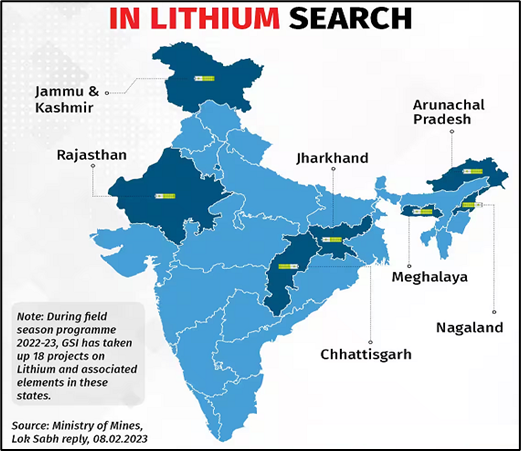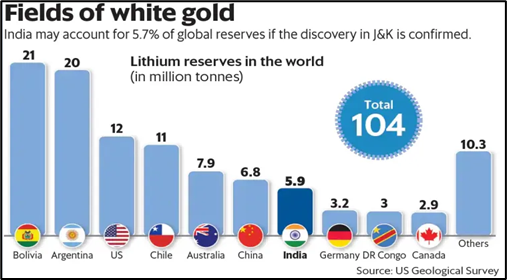Why in News?
The Ministry of Mines was forced to scrap the auction for the lithium block in Jammu and Kashmir’s (J&K’s) Reasi district for the second time, following weak investor response.
This comes nearly 18 months after then Mines Secretary announced the discovery of an inferred deposit of 5.9 million tonnes of lithium ore in Reasi, expected to be among the largest deposits in the world.
What’s in Today’s Article?
- Lithium Reserves in India
- Why Access to or Control over Lithium is Important?
- What is the Reason Behind Investors Staying Away from Li Block Auctions?
- What is the Status of Other Lithium Deposits in India?
- Way Ahead to Boost Li Exploration in India
Lithium Reserves in India:

- Lithium is a soft, silvery-white non-ferrous metal and is one of the key components in rechargeable batteries for mobile phones, laptops, digital cameras and electric vehicles.
- It is also used in some non-rechargeable batteries for things like heart pacemakers, toys and clocks.
- The Geological Survey of India (GSI) had for the first time in India's history established Lithium inferred resources of 5.9 million tonnes in Jammu and Kashmir’s Reasi district.
- Months after India's first lithium reserves, the GSI has found another reserve of the crucial mineral in Degana in Rajasthan's Nagaur district.
- These reserves are believed to be much bigger in quantity (than found in J&K) and can meet 80% of the total country's demand.
Why Access to or Control over Lithium is Important?

- India’s electric-vehicle (EV) market was valued at $383.5 million in 2021, and is expected to expand to $152.21 billion in 2030.
- India imported 450 million units of lithium batteries valued at $929.26 million (₹6,600 crore) in 2019-2020.
- The ongoing global transition to low-carbon economies, the rapid expansion of AI and 5G networks will greatly reshape global and regional geopolitics in favour of those possessing and producing lithium.
What is the Reason Behind Investors Staying Away from Li Block Auctions?
- Difficulties around extracting and processing lithium: From hard rock pegmatite deposits.
- Underdeveloped mineral reporting standards: Used in tender documents.
- Other complaints of prospective bidders:
- Bid documents have limited information of the block,
- Block being too small to apply modern mineral systems-based tools,
- No clarity on whether any beneficiation study had been conducted to assess the feasibility of extracting and processing lithium from the resources identified in J&K,
- Absence of an investor-friendly resource classification code, etc.
What is the Status of Other Lithium Deposits in India?
- In Chhattisgarh:
- The Ministry of Mines successfully auctioned off India’s first lithium block in Chhattisgarh’s Korba district recently.
- Also, a private exploration company funded by the National Mineral Exploration Trust (NMET) has found hard rock lithium deposits ranging from 168 to 295 parts per million (ppm) in Korba.
- In other states:
- Lithium exploration in other states has not been as fruitful.
- In Manipur, efforts to explore lithium in Kamjong district were stalled due to resistance from locals in the area.
- In Ladakh’s Merak block, very close to the border between India and China, a lithium exploration funded by NMET yielded results that are not encouraging.
- In Assam’s Dhubri and Kokrajhar districts, the NMET recommended to drop the plan of upgradation of a lithium exploration.
Way Ahead to Boost Li Exploration in India:
- Need to improve reporting standards:
- Clarity on the economic viability of mining lithium is important as the extraction process is expensive, and with global lithium prices falling significantly, miners are increasingly eager to maintain their margins.
- India’s current resource classification rules are largely based on the UN Framework Classification for Resources (UNFC), which do not provide sufficient information to determine the economic viability of mining a mineral block.
- Most regulatory bodies across the world adhere to the Committee for Mineral Reserves International Reporting Standards (CRIRSCO) template, which requires the reporting of economically viable reserves.
- Hence, India should adopt CRIRSCO-aligned internationally-compliant mineral reporting standards to attract private investment in the sector.
- Allocation to the government companies:
- The blocks that have not received the bare minimum bids should be allocated to the government companies for prospecting or mining operations.
- This is allowed under the Mines and Minerals (Development and Regulation) (MMDR) Act.
- Global best practices: In Chile, the government has designated lithium as a strategic resource and its development has been made the exclusive prerogative of the state.









